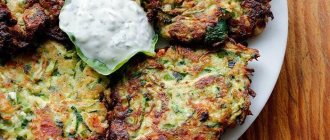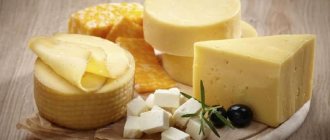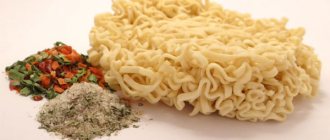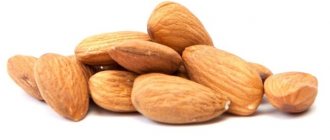One way or another, a diet during lactation poses many questions to a woman about which foods should be abandoned and what can be gradually returned to the menu. Women often have to think about whether it is possible to eat red fish while breastfeeding? This is a very healthy product, rich in microelements and vitamins important for the body. Pediatricians recommend consuming red fish in moderation, the main thing is not earlier than the baby is 3 months old. In order to protect both herself and the child as much as possible from possible negative consequences, a woman should take into account some of the nuances of its preparation and use.
Types of fish
A woman who is breastfeeding can benefit from any sea or ocean products. The main thing is to know the rate of use and method of preparation. Fish can be of any variety, as long as it is low-fat. Pike perch, hake, sea bass, and pollock are considered useful. Red fish is held in special esteem because it is rich in substances that are difficult to find in large quantities in other products. The most recommended during lactation are trout, salmon, salmon. Properly prepared fish saturates the body of mother and child with a huge amount of omega-3 fatty acids, which helps strengthen blood vessels, the muscular system, and improve blood composition. Do not forget that these products are quite strong allergens, so if you are breastfeeding, they should not be consumed immediately after the baby is born.
When to introduce it into the baby's diet?
Pediatricians suggest parents start giving fish no earlier than 10 months. Only after the baby has already eaten meat.
However, there are restrictions; if a child has diathesis or is allergic, then fish products should be offered to him after a year. It is better to start with varieties of white fish; red fish should be introduced a little later if there is no allergy.
Recommendations for introducing complementary foods
Like other products already introduced, you need to start with half a teaspoon. It is better to give it the first time in the morning to see the body’s reaction to the new product. Gradually increase the amount to 150g. Offer your baby fish no more than once a week.
As stated above, fish is very healthy and should be in the diet of not only an adult, but also a child. But there are some dangers. For example, a fish product should not be given on the same day as meat. Since there will be an excess of protein in the child’s body, which will have a negative effect on the condition of the body.
How to cook?
Of course, the baby should be offered boiled fish; after it has already been reliably introduced into the diet and the child grows up, it can be baked. You can make cutlets and meatballs from fish. This will diversify your daily diet. Despite all the positive properties of fish, its consumption should be treated with caution.
Beneficial features
Red fish, like other types of seafood, has a huge number of beneficial properties. The beneficial substances that these products contain have a positive effect on the functioning of all organs and systems. The difference between red fish and other varieties is its saturation with omega-3 fatty acids. This is a necessary element for maintaining the proper functioning of the cardiovascular system, it helps improve the quality of blood and the entire circulatory system. In addition, the beneficial properties of this seafood include:
- Strengthening bones, muscles, hair, teeth in both the baby and the mother, due to the huge amount of phosphorus and calcium, as well as vitamin D, which helps absorb these elements;
- Regulation of metabolic processes in the body, normalization of blood sugar levels;
- Beneficial effect on the functioning of the central nervous system, improving memory, concentration;
- Improving the visual functions of the body;
- It is a preventative against cancer;
- Normalizes the functioning of the digestive system, is quickly absorbed;
- The protein content in large quantities has a beneficial effect on a woman’s kidneys, protects them and prevents the formation of salts and stones.
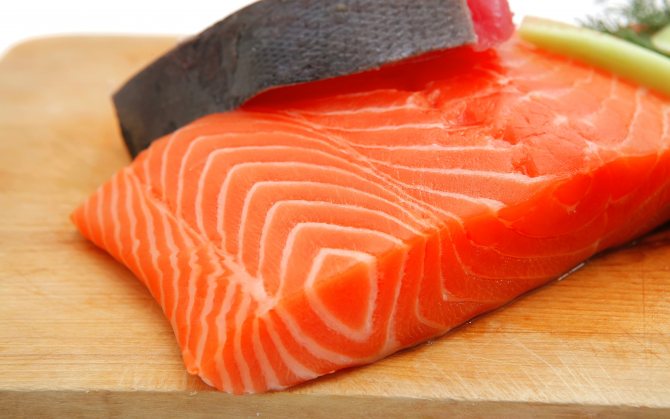
Can a nursing mother eat this product and is it allowed to eat salmon?
Fish is rich in many vitamins and microelements, such as iodine, phosphorus, calcium. In addition to its rich composition, it improves memory and has a beneficial effect on bones. Fish is quickly and easily absorbed by the body, and also normalizes digestion.
This means we can conclude that fish can and even should be consumed when breastfeeding a newborn.
However, there are some restrictions. Since not any fish can be consumed and is beneficial for a nursing mother, because it can cause allergies in the baby.
Most types of seafood, including red fish, are allergens. Most often, allergies manifest themselves in the baby, and not in the mother. Therefore, most mothers limit themselves to its use. However, it is not the most dangerous allergen.
In the first month after giving birth, it is best to eat white fish. In the future, you can introduce red. They introduce it gradually and be sure to watch the baby’s reaction. Initially, dishes should only be boiled. After a few months you can bake.
For mothers, for example, it is safe to eat salmon. It is least likely to cause allergies in children. True, you need to eat it no more than once a week. Salmon contains many vitamins and nutrients:
- vitamins A, D, B;
- phosphorus;
- calcium;
- potassium;
- iron.
Therefore she:
- helps strengthen blood vessels;
- improves blood condition;
- has a positive effect on brain activity;
- prevents stress and improves mood.
In addition, salmon is quickly digested and absorbed by the body. Its use does not cause heaviness in the stomach. In addition to all the advantages presented, it has a low calorie content, which helps women lose weight after pregnancy.
Benefit
- Contains vitamin A, so it is beneficial for vision.
- The high content of vitamin D helps strengthen bones and prevent rickets in children.
- Improves immunity.
- It has a beneficial effect on heart function and blood circulation, as it contains Magnesium and Potassium.
- Strengthens the nervous system.
- Has a positive effect on the digestive system.
- Contains Omega-3 and Omega-6 promotes mental performance.
- Thanks to the content of vitamins B6 and B12, brain function improves.
Why are fish dishes dangerous?
During lactation, a woman should consume red fish with extreme caution. This product is a strong allergen and it is important to follow all recommendations regarding the type of seafood, method of preparation, and time of consumption. In addition to the fact that smoked, fried, and salted fish can be an undesirable product for your baby’s health, canned fish is no less dangerous. Poor quality ingredients, which include preservatives, spices, and salts, can harm the child and cause severe allergic reactions.
Raw seafood is extremely dangerous not only for a nursing mother and baby, but for all people. After all, parasites that can develop in them without heat treatment can lead to serious poisoning and provoke the development of serious diseases. Fish dishes on the table of a nursing woman should be of exceptionally high quality and prepared correctly, based on all recommendations.
Those mothers who have previously encountered food allergies should be wary, since red fish has a huge number of allergenic properties. This can lead to a specific allergic type reaction in the newborn.
Artificially grown red fish may contain various drugs and antibiotics that farmers use for the rapid growth of livestock. These chemical additives pass through breast milk to the baby; frequent use of such a product by a nursing mother can lead to negative consequences for the health of the baby.
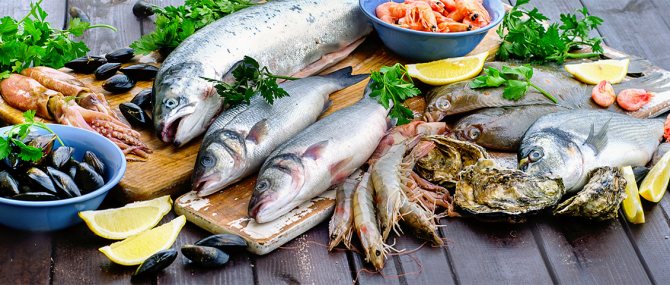
Seafood requires careful processing when preparing
Restrictions when preparing soups for nursing mothers
This begs the question – what can’t you eat? What products are prohibited? It is necessary to completely exclude:
- Beetroot - there is a risk that the abundance of fiber will cause diarrhea in an infant; the burgundy color of the root vegetable is an obvious allergen.
- Cabbage - until the child refuses the mother's breast. The baby’s gastrointestinal tract is unable to cope with such coarse fiber; the soup will cause colic in the baby, so you should avoid cabbage soups.
- Legumes are fraught with increased gas formation, so we exclude lentils, beans, beans, and peas from the diet during breastfeeding.
- Onions and garlic - it’s better to start the first month without them, you can slowly add onions to the broth, but during the first weeks the soup is strained, so the ingredient is not dangerous. Next, onions are acceptable in the diet; garlic is undesirable. They often change the taste of milk, and there is a risk that the baby will refuse the breast.
- Offal. The ingredients are too greasy and heavy for a baby.
Kvass okroshka is a forbidden food for breastfeeding mothers. The yeast present in kvass will provoke fermentation in the child’s gastrointestinal tract. Radishes and fresh cucumbers are not recommended in this dish during the feeding period.
Is it possible to eat red fish during lactation?
The benefits of eating red fish allow women to eat it while breastfeeding. The main thing is not to start using it in the first month of the baby’s life. This is due to the fact that before the age of 3 months, the baby’s digestive system is not yet fully mature and is not ready to become familiar with such products.
Is it possible to eat salmon?
If anyone is wondering whether it is possible to eat salmon while breastfeeding, then there is no need to doubt it. This type has a composition that improves the quality of the circulatory system, brain activity, and memory. If you consume salmon in moderation, it will not cause any negative consequences on the part of mother and baby. The main thing is to cook it exclusively steamed, in the oven or boiled. This is a fairly high-calorie product, but at the same time it is easily digestible.
Trout has similar properties, but with a slightly lower calorie content. Salmon and trout are essential sources of omega-3 fatty acids for a nursing woman and for a newborn baby.
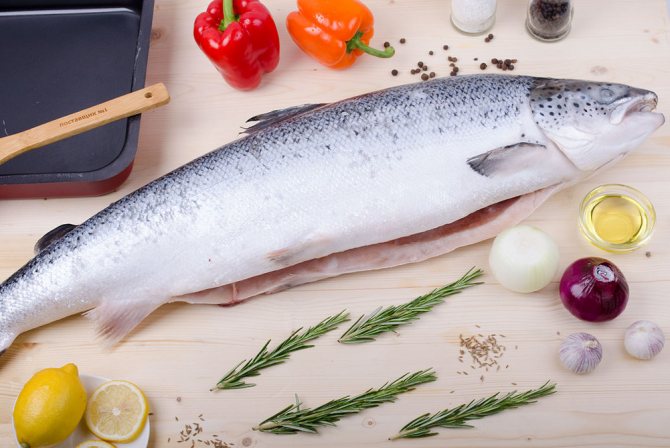
Is it possible to have salted and smoked fish?
No matter how beneficial red fish is for a nursing woman, its properties are lost if cooked incorrectly. Namely, smoked, dried, salted, dried foods contain too much salt, which can cause swelling, water retention in the body, and increase blood pressure. Salted fish is not recommended for breastfeeding, even despite the maximum preservation of all nutrients in it. Smoked fish, unlike salted fish, loses all its beneficial substances during processing and in addition is saturated with carcinogens and other additives. Therefore, a nursing mother should absolutely not consume smoked fish.
Soups allowed in the first month of lactation
Liquid broths, not so desirable in the daily diet, but useful for a woman in the first postpartum weeks. It is not necessary for a nursing mother to start every day with chicken broth, but the first dish should be on the postpartum menu.
Nutritionists suggest the following scheme:
- 1st week. The broth that is offered to a woman should be very liquid, with a minimum of ingredients. Drink it as a hot drink, little by little. The solid components of the dish can remain untouched: strain the broth, drink only the liquid.
- 2nd week. The recipe may contain potatoes, zucchini, dill, spinach, and fresh parsley. Onions and cauliflower are also acceptable. You don’t strain the broth, you eat everything on the plate. Broth boiled with carrots in the second postpartum week is undesirable; introduce it at the end of the first month of a new diet.
Many people cook first courses based on chicken, but it’s better to start with beef. For about a week, it is better to cook broths strictly with beef, then introduce turkey and rabbit with caution. After them comes the turn of the chicken as the basis of the broth.
At the beginning of feeding, you can prepare cereal soups. Try not to make the dish multi-component; 3-5 components are enough.
The diet of a young mother is not a meager menu, but a well-thought-out system that is best planned out several days in advance.
Beef broth soup with buckwheat
You can prepare beef soup from the first postpartum days. When you return from the maternity hospital with your baby, ask your loved ones to prepare a dish with beef broth. Lunch gives you a feeling of fullness, nourishes, is well tolerated, and gives you strength.
Compound:
- 2-2.3 liters of fresh beef broth;
- 0.8 cups buckwheat;
- 1 medium onion;
- 3 medium potatoes;
- greenery.
Vegetables need to be peeled, cut finely enough, and poured into beef broth. Pour washed or fermented buckwheat into it. Cook the dish until done, about 15-20 minutes. Season the dish with herbs before serving. The recipe is useful for mothers during the postpartum period; its composition helps overcome anemic symptoms and promotes rapid recovery.
Vegetable puree soup with meat broth
Compound:
- 2-2.3 liters of any meat broth (turkey, rabbit, veal);
- 270 g spinach;
- 270 g sorrel;
- half a large onion;
- 1 medium carrot;
- 1 spoon of low-fat sour cream (but not low-fat).
Separately cook the meat broth, be sure to strain it. While it is cooking, in another saucepan, cook the spinach, sorrel, onion and carrots, after finely chopping them. Once ready, grind the cooked vegetables in a mortar or blender and add to the prepared broth. You can season the dish with sour cream (to taste).
This thick vegetable soup contains the products necessary for fortified, high-quality nutrition, which is what the mother needs during postpartum rehabilitation.
Rules for eating red fish during breastfeeding
It is advisable to start eating fish while breastfeeding in the morning with a small piece of 30-50 g. Then you need to monitor the baby’s reaction throughout the day. It is advisable not to try a woman 2 new products at once, so that it is easier to find out what could cause the reaction. If negative consequences are found in a child (allergic reaction, constipation, diarrhea, colic, poor sleep), then this product should be removed from the diet. It is advisable to continue introducing the newborn to this ingredient no earlier than 1 month.
When can it be introduced into the diet and in what quantity?
It is advisable to introduce red fish into the diet when breastfeeding no earlier than the baby is 3 months old. For the first time, 50 g per day is enough, then you can increase the portion of the fish dish to 100 g per day. It is enough to eat fish twice a week.

Is it possible to eat pink salmon while breastfeeding?
New mothers can start eating seafood two weeks after giving birth. However, before consumption, it is recommended to consult a doctor, as this is due to a possible allergic reaction to food that can be transmitted to the child.
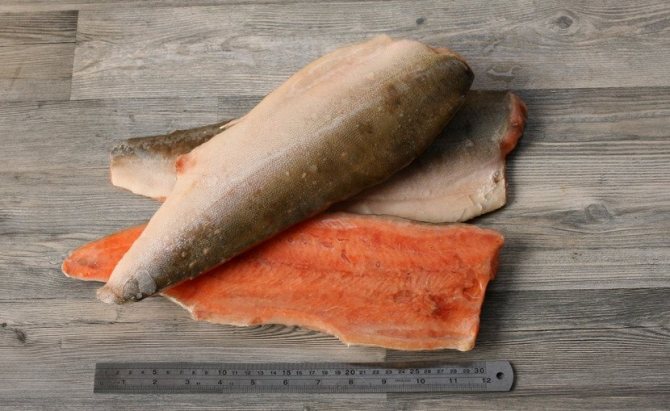
As for the red meat of marine organisms, it is added to the diet gradually and with caution, after the inclusion of white fish meat in the diet. In this regard, during the first month of a baby’s life, his mother should not risk trying pink salmon. It is recommended to start 90 days after birth.
Important! It is not advisable for nursing mothers to eat salted, raw and dried fish. This cooking option negatively affects a woman’s lactation and the baby’s digestion.
Tips for choosing
To protect both herself and the baby from negative consequences, a woman should be able to choose quality products.
Tips for choosing red fish when breastfeeding:
- It is not recommended to buy artificially grown fish (the place of cultivation must be indicated on the label);
- It should be chilled, not frozen;
- When pressed, the meat should be elastic;
- Too rich red color of the meat indicates artificial cultivation and the addition of chemicals;
- The fish must be whole, clean, with transparent, not cloudy eyes, without an unpleasant odor.
Harm
- You should not eat raw fish or even lightly salted fish , especially for breastfeeding mothers and babies. This can lead to a severe allergic reaction, and the most dangerous thing is poisoning and infection with various infections.
- It is worth limiting your consumption of exotic fish. Because they may contain high mercury content. Such fish include shark, cod, and tuna.
- It is better to give children processed fish, for example in the form of cutlets. If you eat fish in pieces, bones may get in.
Red fish recipes for nursing mothers
Only a properly prepared dish can benefit the mother and child’s body. Fish dishes for a nursing mother should be dietary, with a small amount of ingredients.
Fish soup
Ingredients:
- Red fish – 300 g
- Potatoes – 2-3 pcs.
- Rice – 4 tbsp.
- Carrots – 1 pc.
- Celery – 1 piece
- Tomato paste – 2 tbsp.
Method of preparation: Boil seafood in salted water with the addition of bay leaf. Separate meat from bones. Add diced potatoes and rice cereal to the fish broth. After 15 minutes, add carrots and celery sauteed in tomato paste, as well as boiled fish meat. Boil for another 4-5 minutes, add herbs. The soup is ready.
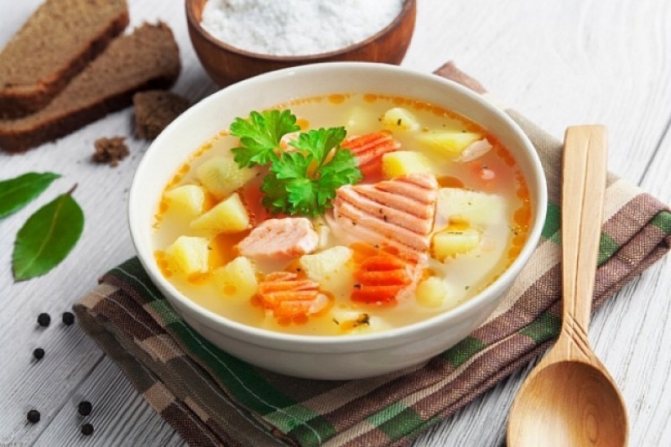
Steamed fish cutlets
Ingredients:
- Red fish fillet – 300 g.
- Egg – 1 pc.
- Oatmeal – 1 tbsp.
- Onion – 1 pc.
- Lemon – 1 slice
- Greenery.
Method of preparation: Grind seafood meat in a meat grinder, add chopped onion, oat bran, egg, finely chopped herbs. Mix the resulting mixture well, add salt, pepper to taste and lemon juice. Let the fish mixture sit for 15 minutes in a cool place. Next, you need to form small cutlets and steam them for a few minutes until cooked.
A nursing mother should return to her usual menu gradually, taking into account all the recommendations of pediatricians. Red fish on a woman’s table during breastfeeding should be of exceptionally high quality and prepared with maximum benefit for the body. Fatty varieties of fish, as well as improperly prepared fish dishes, will not bring any benefit, but will only worsen the health of mother and baby. An irreplaceable source of omega-3 fatty acids not only helps a woman cope with postpartum weakness of the body, but also improves the functioning of many organs and systems of a young child’s body.
How to cook trout and salmon for nursing
When preparing trout and salmon, use fresh herbs, sour cream or lemon juice. Porridge, rice, boiled potatoes or mashed potatoes are suitable as a side dish. For the first tasting, baked or boiled salmon or trout are perfect. To diversify the diet of a nursing mother, we offer recipes for simple and tasty fish dishes.
To prepare baked fish, the carcass is washed and cleaned, cut into pieces two centimeters thick and soaked in salted water for two hours. Then the pieces are salted and lightly peppered, wrapped in foil in groups of three and placed on a baking sheet with low sides. Pour some water into the bottom of the baking tray. Bake the fish at 180 degrees for 30-40 minutes.
Fish balls
- Fish fillet – 300 gr;
- Chicken egg – 1 piece;
- Breadcrumbs – 1 tbsp. spoon;
- Grated hard cheese – 50 grams;
- Carrots – 1 pc.;
- Onion 1 pc.;
- Salt and pepper to taste.
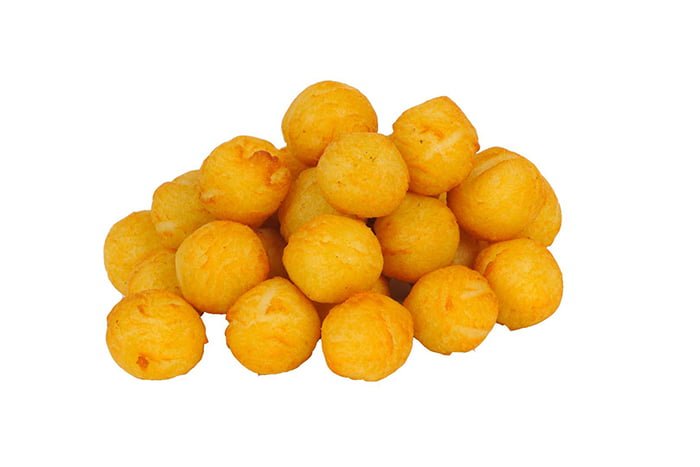
Boil fish meat in salted and peppered water, grind until minced. Peel and chop the onions and carrots. Mix the prepared minced meat and vegetables, add a raw egg and a little broth after cooking the fish. Mix the ingredients thoroughly, add pepper and salt, and form the mixture into balls. Line a baking tray with baking paper and place balls on top. Sprinkle the dish with lemon juice and place in the oven. Cook for 1.5 hours at 180 degrees. 15 minutes before ready, sprinkle the balls with breading and grated cheese.
Fish stuffed with buckwheat porridge
- Fish (whole carcass) – 750 g;
- Boiled chicken eggs – 2 pcs.;
- Boiled buckwheat – 100 g;
- Onion – 1 pc.;
- Sour cream – 1 glass;
- Flour – 1 tbsp. spoon;
- Salt to taste.

The whole carcass is cleaned, the abdomen is cut, the head is separated and the entrails are removed. The inside of the fish is thoroughly washed, dried with a towel, and salted. The eggs are cut and mixed with buckwheat porridge. The mass is placed inside the carcass and the fish is dredged in flour, put in the oven for five minutes and then greased with sour cream. Then bake the dish for half an hour at 180 degrees, brushing the fish with sour cream every five minutes.
Steamed fish cutlets
- Fish fillet – 300 gr;
- Chicken egg – 1 pc.;
- Oat bran – 2 tbsp. spoons;
- Onion – 1 pc.;
- Lemon juice – 1 teaspoon;
- Greens (parsley and celery) and spices to taste.
Pass the fish through a meat grinder, finely chop the onion and mix with the resulting minced meat. Add bran and egg. Chop the greens and add to the minced meat. Mix the mixture, add salt and pepper, and add lemon juice. Stir and leave for 15 minutes. Cutlets are formed from the resulting mass and steamed for two to four minutes. More recipes for nursing mothers at the link https://vskormi.ru/mama/recepti-dla-kormiashih-mam/.
Pink salmon on the menu of a nursing mother
To answer the question whether pink salmon can be breastfed, you should consider the beneficial properties of the product and possible contraindications for including this fish in the diet during lactation.
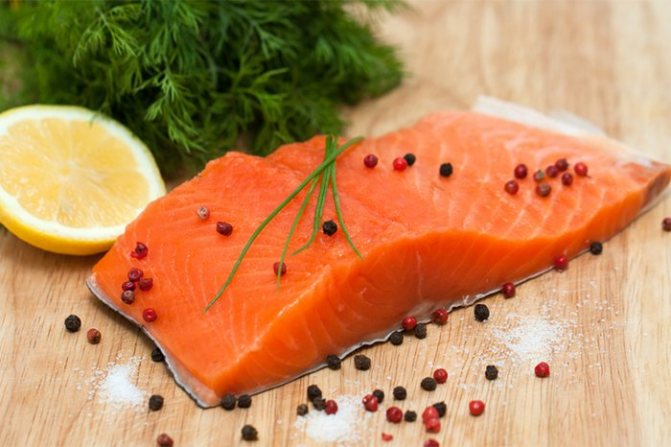
Fish dishes are recommended for nursing mothers, as they are a source of easily digestible protein and essential fatty acids for the body. But not all types of fish can be safely consumed while breastfeeding. In addition, you should be careful when choosing the product itself, since it must be of high quality.

